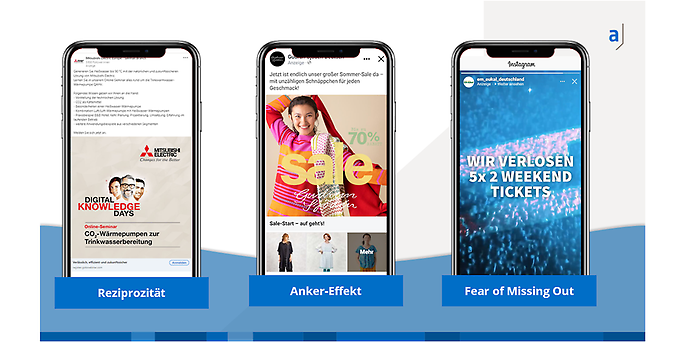14. August 2023 By Mia Rauchschindel
How to use psychological triggers and consumer buying behaviour for your next advertising campaign
In the digital world, the current flood of advertising and large number of products makes it more important than ever to understand the buying behaviour of users and to act accordingly. Retail prices have increased by 80 per cent in 2023, further reducing user demand. People are holding off making particularly large purchases or are making fewer in general this year.
Digital advertising gives companies the opportunity to influence people’s buying behaviour and reach the appropriate target groups in a targeted way. But how can we anticipate users’ buying behaviour and build in the right psychological triggers? I will show you how to take your campaign to the next level using the involvement matrix and different psychological triggers.
Buying incentives and purchase decision typologies
The buying behaviour of users is a complex phenomenon that is influenced by a multitude of factors. These include personal likes and dislikes, general behaviour patterns, as well as social and cultural influences.
In order to better understand the different types of shoppers, they can be subdivided into purchase decision typologies (as shown in the first figure) in the form of the involvement matrix.
This matrix distinguishes between emotional involvement and cognitive involvement. Extensive purchase decisions are decisions that the buyer thinks about for a long time, as they require a high level of involvement both cognitively and emotionally. An impulsive purchase decision is when the buyer does not need to compare the product against others or rationalise their decision, but they still receive the emotional benefit of it.
Limited purchase decisions, however, have the opposite view (high cognitive involvement, low emotional involvement). These product purchases are deliberate and rational. Finally, the habitualised purchase decision is the opposite of the extensive purchase decision (low cognitive and emotional involvement). These are purchases that are made without thinking and are usually always the same products.
How can the involvement matrix help our ads?
The involvement matrix can help to segment your products or services according to different target groups in order to focus your campaigns and advertising objectives more efficiently on the correct target group.
Let us take an everyday object as an example, such as a simple toothbrush. I would expect many users to have a low emotional and cognitive involvement when buying a toothbrush and thus a more impulsive buying behaviour. A user would start his or her user journey by looking for a toothbrush in a shop. The person finds a toothbrush in their favourite colour and subsequently buys it. However, if the person already had a favourite toothbrush, they would grab that one again and thus make a habitualised purchase decision.
How would the process work it were an electric toothbrush? In this case, I would expect that the cognitive involvement and thus the information that a user needs before deciding to buy the product will increase. This would make it a limited purchase decision.
Okay, let us move away from the toothbrush example and look at a car instead. For many people, this purchase triggers an extensive purchase decision. They want the car to reflect their personality, but they still need to be able to justify the decision to themselves or their neighbours with a rational explanation (for example the price or the technology).
By understanding these purchase decision typologies and taking them into account in our campaigns, we can better assess the behaviour of the target group and guide them more effectively through the respective decision-making process. If a product requires more cognitive performance, such as buying an air conditioner, the user journey could be extended in this respect to give the users more touchpoints with the company.
Psychological triggers in digital advertising
In addition to the different purchase decision typologies, there are a number of psychological triggers in digital advertising that we can use to influence users’ buying behaviour. The following triggers are worth looking at in more detail so that you can benefit from them in the next campaign.
FOMO
FOMO stands for ‘fear of missing out’, as in the fear of missing out on something that others get to experience. The FOMO effect is particularly common in today’s digital world. For example, people are constantly gaining insights into other people’s experiences and activities through social media. Influencer marketing also likes to use this trigger. This strategy sees influencers present different products or experiences that users then also want to try.
FOMO can be used in digital marketing to increase engagement and sales by providing exclusive offers or running limited-time promotions.
Anchor effect
The anchor effect, also called anchoring, is a cognitive bias in which people rely too heavily on the first piece of information they receive (the ‘anchor’) when making a decision. This first impression often influences subsequent judgements and decisions, even if the anchor is no longer present.
In marketing, this can have an effect on a number of things, such as how the price of a product is communicated. If, for instance, an advert states that the price (which is the anchor here in the case of initial interest) has been reduced, then this reduced price is automatically perceived as a good offer and thus promotes buying behaviour.
Reciprocity
The principle of reciprocity is based on the human tendency to return a gesture or favour that the person has received. This behaviour can be observed in many cultures around the world and plays an important role in social interactions and relationships.
For example, if you advertise online offering free info seminars, additional information or free samples, this can cause users to feel they have to return the ‘friendly gesture’ and engage more with the brand. This trust can be consolidated afterwards by providing continuous high-quality products and consistent brand communication.

This image shows three adesso advertising campaigns. The FOMO effect shows the campaign by Em-Eukal. Here, tickets for a festival were raffled. The anchor effect shows an advertisement by Gudrun Sjöden, which is currently on sale. The reciprocity trigger shows the registration for a free information seminar on air heat pumps.
Other triggers in advertising psychology
There are plenty of other triggers that are often used in marketing in addition to the ones we have already mentioned here. These include, for example, the trigger ‘sympathy’, which tries to create an emotional bond through authenticity. The influencing factor of ‘authority’ uses experts and certificates to build trust, while creating a sense of scarcity or novelty also helps boost the target’s groups interest and willingness to buy.
Your advertising campaigns in good hands (H2)
Understanding buying behaviour and using psychological triggers in digital advertising can have a significant impact on the success of your marketing strategies. At adesso, we would be more than happy to help you develop a suitable user journey for your product or service and work together to create powerful campaigns that benefit from our insights into advertising psychology.
You can find more exciting topics from the adesso world in our previously published blog posts.

